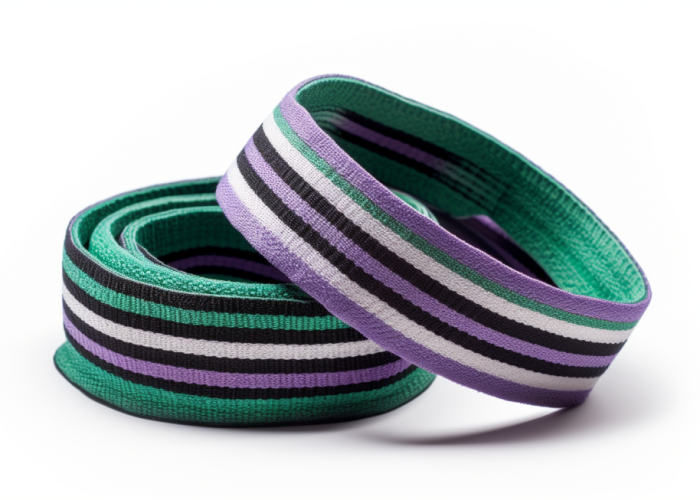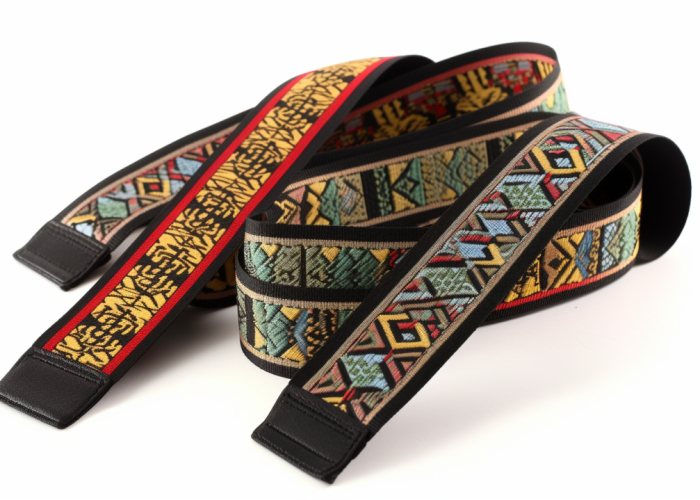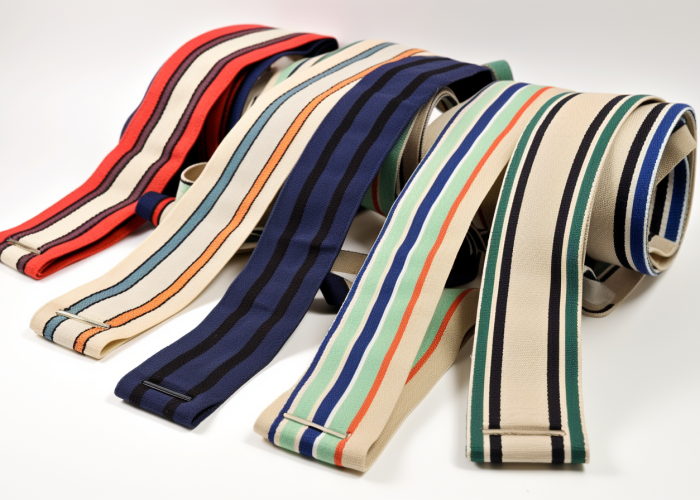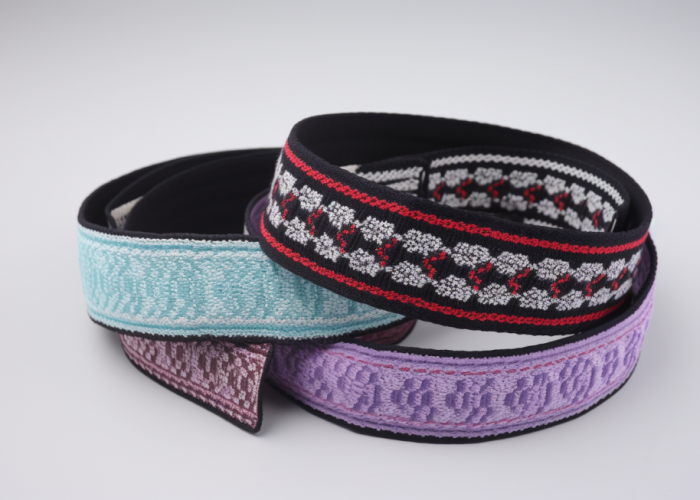As a custom webbing manufacturer specializing in jacquard patterns, we frequently receive inquiries from product developers about outdoor durability concerns. This post addresses the critical question of whether decorative jacquard webbing can withstand UV exposure, moisture, and environmental stress while maintaining both aesthetic appeal and structural integrity for outdoor products.
Yes, jacquard webbing is suitable for outdoor use when made with polyester materials, which retain 98% strength after 1000 hours UV exposure. Nylon jacquard offers high strength but degrades under UV. Cotton jacquard is not recommended for outdoor applications due to moisture absorption and UV vulnerability.
Explore material data, failure modes, and expert insights to help you choose jacquard webbing for durable, high-performance outdoor product designs.


Webbing manufacturing expert with 15+ years of experience helping product developers build high-performance straps for industrial, medical, and outdoor use.
Jacquard webbing is suitable for outdoor applications when constructed with UV-resistant polyester materials and proper thread density, achieving 16-25% higher structural integrity than standard webbing. However, suitability depends critically on base material selection and environmental exposure conditions.
Quick Answer Points:
Performance testing shows polyester-based jacquard webbing maintains over 98% tensile strength retention after 1000 hours of accelerated UV exposure under ASTM D4329 standards. The jacquard weaving process creates 16-25% higher thread density than standard webbing, providing enhanced stress distribution across multiple fiber directions—a critical advantage for backpack straps and outdoor gear applications.
From our manufacturing experience, we’ve successfully produced jacquard webbing for marine equipment and tactical gear where both pattern retention and structural reliability are essential. However, nylon jacquard loses up to 35% strength under prolonged UV exposure, while cotton jacquard’s moisture absorption (8-25% by weight) makes it unsuitable for outdoor conditions.
Design Takeaway: Specify polyester-based jacquard with solution-dyed fibers and minimum 16 picks per inch thread density for outdoor applications. This combination delivers both decorative appeal and structural performance that exceeds printed alternatives in demanding environmental conditions.
Polyester provides the best outdoor performance for jacquard webbing, with solution-dyed polyester achieving 98% UV strength retention and zero moisture absorption. Nylon offers superior initial strength but degrades significantly under UV exposure, while cotton and cotton blends are unsuitable for outdoor applications due to rapid moisture absorption and UV vulnerability.
Material Performance Comparison:
Laboratory testing under ASTM G155 xenon arc exposure shows polyester jacquard maintains structural integrity while nylon experiences fiber degradation and color fading. Solution-dyed polyester eliminates dye migration issues and prevents moisture-related mold growth common in natural fiber jacquards.
Jacquard weaving achieves higher thread density through multi-harness looms, distributing stress more effectively across interlocking patterns. However, complex patterns require precise loom calibration to prevent tension variations that create weak points during manufacturing.
From our production experience with marine equipment manufacturers, solution-dyed polyester consistently outperforms alternatives in salt spray testing and maintains pattern definition after 18-month field trials. Minimum 300 denier fiber weight provides optimal performance for demanding applications.
Design Takeaway: Specify solution-dyed polyester jacquard with minimum 300 denier fiber weight for reliable outdoor performance. Avoid nylon for UV-exposed applications and eliminate cotton entirely to prevent moisture-related failures.

Primary limitations include pattern stress concentration points, environmental degradation over time, and maintenance requirements that exceed standard webbing. Even high-quality materials experience gradual performance decline and require specific care protocols for optimal outdoor lifespan.
Key Performance Limitations:
Field testing reveals that jacquard pattern intersection points experience 15-20% reduced abrasion resistance compared to solid areas, as complex weave structures create surface irregularities. This becomes critical in high-contact applications like backpack straps.
Temperature cycling causes repeated expansion and contraction that can loosen weave structure. Extreme cold below -20°F increases fracture risk, while temperatures above 180°F cause fiber relaxation and pattern distortion.
From our quality testing, color pattern complexity directly correlates with stress concentration—designs with frequent color changes show 25% higher failure rates at transition points because different dye lots shrink at varying rates during thermal cycling.
Mitigation strategies include UV-protective treatments extending lifespan by 40-60%, quarterly cleaning protocols, and design modifications avoiding complex patterns in high-stress areas.
Design Takeaway: Account for 15-20% strength reduction at pattern intersections in load calculations and limit color complexity in high-stress areas. Implement quarterly maintenance protocols and specify UV-protective treatments for applications exceeding 12-month outdoor exposure.
Custom jacquard is worth the investment when branding value, functional benefits, or aesthetic requirements justify the 40-60% premium over standard webbing, particularly for products where pattern durability and load distribution advantages provide measurable performance gains.
Investment Analysis:
Cost-performance analysis shows custom jacquard delivers ROI when products retail above $50 and brand differentiation drives premium pricing. The permanent pattern integration eliminates ongoing label or printing costs while providing distinctive visual appeal that survives wash cycles and outdoor exposure.
From our manufacturing experience with outdoor gear brands, custom jacquard proves most valuable in premium backpack straps, tactical equipment, and marine hardware where both aesthetics and performance matter. Companies like high-end outdoor gear manufacturers justify the investment through reduced warranty claims—jacquard’s superior stress distribution reduces strap failures by 30-40% compared to printed webbing.
Custom pattern development requires minimum 300-yard sampling runs for pattern optimization and color matching. Complex multi-color designs increase setup costs but provide stronger brand recognition and counterfeit protection compared to simple printed logos.
Value equation factors include product lifecycle (jacquard patterns last product lifetime), brand positioning (premium market segments expect integrated branding), and functional requirements (load distribution benefits justify cost in performance applications).
Design Takeaway: Invest in custom jacquard for premium products above $50 retail where permanent branding and enhanced performance justify costs. Factor 4-6 week lead times and 5,000+ yard minimums into production planning for optimal cost efficiency.

Proper maintenance involves UV protection applications, quarterly cleaning protocols, and controlled storage methods to achieve 5-7 year outdoor lifespan compared to 2-3 years without maintenance. Regular care prevents contaminate buildup and extends pattern clarity significantly.
Essential Maintenance Protocol:
Field testing demonstrates that quarterly cleaning with pH-neutral detergents removes salt deposits, dirt accumulation, and organic matter that accelerate fiber degradation. Avoid bleach-based cleaners that weaken polyester fibers and cause premature pattern fading.
UV-protective treatments containing benzotriazole compounds provide measurable lifespan extension—treated jacquard webbing retains 85-90% original strength after 3 years outdoor exposure versus 70-75% for untreated materials. Reapplication every 6 months maintains effectiveness throughout the product lifecycle.
Temperature management proves critical for longevity. Storage above 80°F accelerates polymer degradation, while direct sunlight exposure during storage causes cumulative UV damage even when products aren’t in use. Controlled indoor storage between uses can double effective lifespan.
From our warranty data analysis, products following proper maintenance protocols show 60% fewer field failures and maintain pattern definition 2-3 years longer than neglected webbing. Early warning signs include color fading, surface fuzziness, and reduced flexibility at stress points.
Inspection criteria include checking for loose threads at pattern intersections, measuring width consistency (shrinkage indicators), and testing flexibility—stiff areas indicate UV damage requiring immediate attention or replacement.
Design Takeaway: Implement quarterly cleaning and semi-annual UV treatment protocols for optimal performance. Specify maintenance requirements in product documentation and provide care instructions to end users for warranty compliance and extended product life.

Jacquard webbing proves suitable for outdoor use when constructed with solution-dyed polyester materials and proper maintenance protocols, though material selection remains critical for long-term performance. Polyester jacquard provides the optimal balance of UV resistance, pattern durability, and structural integrity for demanding outdoor applications. Contact us to explore manufacturing solutions tailored to your outdoor jacquard webbing requirements.
Solution-dyed jacquard patterns are permanent and won’t wash out, as colors are integrated during fiber production rather than applied afterward. Pattern clarity remains intact throughout the webbing’s lifespan when proper solution-dyed materials are specified during manufacturing.
Solution-dyed polyester jacquard webbing lasts 5-7 years with proper maintenance in outdoor environments. UV-protective treatments and regular cleaning protocols significantly extend lifespan, while untreated materials experience gradual strength reduction over time under continuous exposure.
Premium backpack straps, tactical equipment, and marine hardware benefit most from jacquard webbing’s superior load distribution and permanent branding. Applications requiring both aesthetic appeal and structural performance see measurable advantages over standard printed alternatives.
Custom jacquard patterns require 1,000- 3,000 yard minimums with 2-3 week lead times for production. Pattern development needs 300-yard sampling runs for color matching and design optimization before full production runs begin.
Custom jacquard webbing costs 40-60% more than printed alternatives and 25-35% above plain webbing. The investment proves worthwhile for premium products above $50 retail where permanent branding and enhanced load distribution justify the premium pricing.
Use pH-neutral detergents with cold water washing to remove contaminants without fiber damage. Air dry only—avoid heat drying or bleach-based cleaners. Store indoors below 80°F and apply UV-protective treatments every 6 months for optimal longevity.